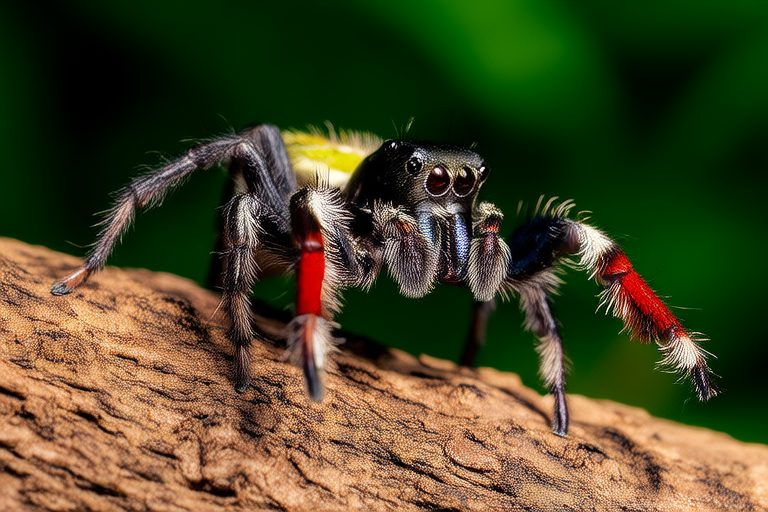Mexican Redknee Tarantulas: Majestic Arachnids
The Mexican Redknee Tarantula (Buthus smithi, formerly known as Brachypelma smithi) is one of the most iconic species within the tarantula family. Known for its striking appearance and gentle demeanor, this spider has captured the hearts of many arachnid enthusiasts. In this article, we will delve into the world of the Mexican Redknee Tarantula, exploring their habitat, diet, behavior, and care tips for owners. We’ll also dispel common myths surrounding these magnificent creatures and highlight their unique characteristics that make them truly majestic.
Appearance: A Masterpiece of Nature
The Mexican Redknee Tarantula boasts a stunning appearance that sets it apart from other tarantula species. Adults can reach lengths of up to 5 inches (13 cm) and weigh approximately 1.5 ounces (43 grams). Their legs are covered in thick, dark hairs, while their abdomen features vibrant reddish-brown markings. The most distinctive feature, however, is the red bands on the joints of their legs, particularly noticeable on the knees, hence the name ‘Redknee.’
These spiders have evolved over millions of years, developing defensive mechanisms such as urticating hairs and venomous fangs. However, contrary to popular belief, their venom is generally harmless to humans, causing only mild irritation similar to a bee sting.
Habitat: Thriving in Arid Environments
Native to the Pacific coast of Mexico, specifically the states of Guerrero and Oaxaca, the Mexican Redknee Tarantula thrives in arid, semi-desert environments. They prefer rocky outcrops and caves, where they can find shelter from predators and extreme weather conditions. These habitats offer ample opportunities for burrowing, which is essential for the tarantula’s survival.
In captivity, it is crucial to replicate their natural environment as closely as possible. Providing a spacious enclosure with a substrate deep enough for digging and a humid microclimate helps ensure the tarantula’s well-being. This setup mimics the cool, moist crevices they inhabit in the wild, promoting healthy growth and longevity.
Diet: Carnivorous Predators
Mexican Redknee Tarantulas are carnivorous predators, feeding primarily on insects, small vertebrates, and other arachnids. In the wild, they use their powerful front legs to catch prey and inject venom through their fangs. Once immobilized, the tarantula secretes digestive enzymes onto the prey, turning it into a liquid meal that it then slurps up.
In captivity, feeding your tarantula can be both educational and entertaining. Suitable prey items include crickets, mealworms, and occasionally pinky mice. It is important to ensure that the prey is appropriately sized and does not pose a threat to the tarantula. Overfeeding or providing unsuitable prey can lead to health issues, so moderation is key.
Behavior: Solitary and Gentle Giants
Mexican Redknee Tarantulas are solitary creatures, living alone except during mating season. They are nocturnal, spending most of the day hidden in their burrows and emerging at night to hunt. Despite their intimidating appearance, these spiders are surprisingly docile and rarely aggressive towards humans. When threatened, they may flick off urticating hairs from their abdomen or retreat into their burrow.
One of the most fascinating behaviors of the Mexican Redknee Tarantula is their molting process. During this time, the tarantula sheds its exoskeleton, revealing a new, softer version underneath. This process can take several hours, and the tarantula remains vulnerable until the new exoskeleton hardens. As a responsible owner, it is important to provide a quiet environment and avoid handling the tarantula during this delicate period.
Care Tips for Owners
Owning a Mexican Redknee Tarantula requires commitment and proper care. Here are some essential tips to ensure the well-being of your pet:
- Enclosure Setup: Provide a spacious tank with a substrate depth of at least 6 inches (15 cm) to allow for burrowing. Include hiding spots such as cork bark or clay pots.
- Temperature and Humidity: Maintain a temperature range of 75-85°F (24-29°C) and humidity levels between 60-80%. Use a hygrometer to monitor humidity and adjust accordingly.
- Feeding: Feed your tarantula once every week or two, depending on its size and activity level. Remove uneaten prey after 24 hours to prevent contamination.
- Handling: Handle your tarantula sparingly and gently. Always support its body and avoid squeezing or pinching.
Myths vs. Facts
Despite their popularity, there are several misconceptions about Mexican Redknee Tarantulas:
- Myth: All tarantulas are dangerous to humans. Fact: While tarantulas possess venom, it is generally harmless to humans, causing only mild irritation similar to a bee sting.
- Myth: Tarantulas are aggressive and will attack humans. Fact: Mexican Redknee Tarantulas are generally docile and prefer to avoid confrontation. They will only defend themselves if provoked.
- Myth: Tarantulas are social animals. Fact: Tarantulas are solitary creatures, living alone except during mating season.
Why They Are Considered Majestic
The Mexican Redknee Tarantula is more than just a fascinating arachnid; it is a symbol of resilience and adaptability. Their ability to thrive in harsh desert environments, coupled with their striking appearance and gentle nature, makes them truly majestic. Moreover, their role in controlling insect populations and contributing to biodiversity highlights their ecological importance.
For enthusiasts and casual observers alike, the Mexican Redknee Tarantula offers a window into the intricate world of arachnids. By understanding and appreciating these creatures, we can foster a greater respect for all life forms and contribute to their conservation.
Conclusion
The Mexican Redknee Tarantula is a remarkable species that captivates both scientists and hobbyists alike. From their striking appearance to their intriguing behaviors, these spiders offer endless fascination. By providing the right care and respect, we can ensure that these majestic arachnids continue to thrive in captivity and in the wild. Whether you’re a seasoned enthusiast or a curious observer, the Mexican Redknee Tarantula is sure to leave a lasting impression.
